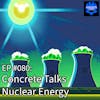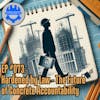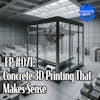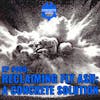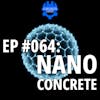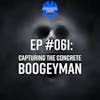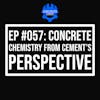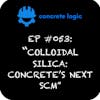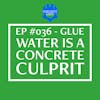EP #052: Concrete Phoenix Rises
Join us on the Concrete Logic podcast as we dive deep into the fascinating world of water-cement ratio and its crucial impact on the strength and durability of concrete. Special guest Tyler Ley, renowned concrete expert and YouTube sensation, unveils a groundbreaking new water-cement ratio test that will revolutionize the construction industry.
Get ready to be captivated by the discussion as we explore this game-changing concrete test technique's origins, importance, and untapped potential. Don't miss out on this eye-opening episode that promises to redefine your understanding of concrete testing forever! Episode References Guest: Tyler Ley | OSU | tyler.ley@okstate.edu Guest Website: https://www.concretephoenix.com/
Producer: Jodi Tandett, Joshua Smith Become a Producer: https://www.concretelogicpodcast.com/support/
Music: Mike Dunton | https://www.mikeduntonmusic.com | mikeduntonmusic@gmail.com | Instagram @Mike_Dunton Host: Seth Tandett, seth@concretelogicpodcast.com
Host Website: concretelogicpodcast.com
Seth: [00:00:00] /Welcome to another episode of the Concrete Logic podcast, and I have another returning guest this week. Tyler Ley from Oklahoma State. I was thinking the other day I don't, I we're, I think we're about the same age, but do you remember the the, guys I used to g tour around the, I think they toured around the United States, the AND1 basketball guys, and they had these really cool names and everything.
Tyler Ley: I don't. A little bit, a little
Seth: Anyways, there's this one guy called the professor. Nice. He was really good at dribbling and behind his back and everything. And when I think of the professor in concrete, you're the guy.
Tyler Ley: Thanks man. Yeah.
Seth: So I know you, you like the concrete freak and that and that stuff on YouTube and everything, but when I think of the professor, That's Tyler Ley.
Seth: Thank you, Seth.
Seth: That's an honor man. I've, yeah. I, am a professor. We're, not all [00:01:00] created equal. And we don't all put you to sleep we, do our best to try to keep you awake and help people move our industry forward. Yeah.
Seth: I've told folks before you, you need to check out Tyler's YouTube videos.
Seth: They're, Very entertaining. And they also are you, learn something obviously too. Tyler teaches for a living, so that's pretty awesome. The way he he does things on YouTube but Tyler I reached out to you because I was on your YouTube channel and you had a thing about a new water cement ratio test.
Seth: I wanted to bring you on so you could talk about it, cuz I was a little bit confused about how it works. But first can we talk about the water cement ratio? Why is important, the origins of it all?
Seth: Yeah, if you could,
Seth: water cement ratio is the amount of water in your concrete divided by the amount [00:02:00] of cementitious.
Seth: So cement. SCM's it could be at fly ash, could be slag, could be something like that. Basically the water divided by the binder.
Seth: And why that matters is that the more water you add, the more you're diluting your binder in your mix. The stuff that glues everything together, the stuff that gives you strength, the stuff that gives you low permeability, concrete.
Seth: And there are times when we need really consistent concrete, really high performance concrete, really to make sure that we get the recipe correct. And right now, there's not a great tool to do that. So you can do a moisture cookoff on your ready mix truck on your aggregates, right? Find your moisture content of your cores and moisture content of your sand.
Seth: And I hope most people are correcting for that or watching for that, and changing for that. That's, a [00:03:00] key quality step. But then there's just other ways that water finds its way in into the concrete mixture. Sometimes there's some extra water in the drum. Sometimes there's the moisture corrections are, off.
Seth: Sometimes , at the wash rack, some water gets added. Sometimes on the job site, the people just decide that it's not what they want and they wanna bring it to whatever they think they want in, the moment. If that if, there's water available to be added, those aren't problems. Okay.
Seth: They're not. But, if there's not, that, that can become an issue. And on certain jobs we just want really consistent concrete. So like a slab on grade, like a large industrial floor slab where. Where the concrete finisher is all about, they want uniform. They, want to control the set time.
Seth: They don't want one thing setting and another thing not setting. They, wanna control their finishing. They don't [00:04:00] want one part wet and another part dry. And so water is truly the one variable that would help out with that. And we've known this a long, time.
Seth: T.C. Powers figured this out a long, time ago.
Seth: One of my heroes of concrete, right? He figured this out a, long time ago, and we've known it. It's in all the textbooks. I hope everyone's learned it before or remembers hearing about it. It's just we've never had a tool to measure it. And when you can't measure something, Then you can't really know where it's at.
Seth: You can't really control it. You can't really get it to where you want it to go. It's just kinda, it's challenging. It's really, challenging. And so I've known about this for a long time ever since I was like first learned about concrete my advisor my, my, teachers would tell us,
Seth: yeah, water sprint ratio is the most important thing out there.
Seth: No way to measure it. Yeah. I'm like, what? [00:05:00] Holy cow. There's gotta be some way.
Seth: Some people will tell you the slump test measures it.
Seth: No, the slump test is cool. It's simple, it's easy. I think it's, I think the slump test tells you about consistency but I don't think the slump test tells you how much water's in, your concrete.
Seth: There's a lot of things that can change the slump test. Okay. And then some people will say no, the strength, test cylinders there's a lot of things that impact cylinder strength, a whole bunch of stuff. And I would say one of the biggest ones out there is how people handle cylinders.
Seth: Okay. In our industry, we don't always do the best job of keeping track of those cylinders handling the way they're supposed to. And, that's tough cuz that's people's pay that's based on that and that that's, challenging. But, water can impact slump.
Seth: It can, and water can definitely impact strain. It can. But I just think there's a value out there, or a it should be [00:06:00] we, should be focusing on measuring things, consistency consistently and, things that, that, that are helpful. And I think the, Phoenix helps that with water.
Seth: Now, some of your listeners, some of your really astute listeners out there might say, oh Microwave oven test, And there's this test that you take concrete and you cook it in a microwave and you basically figure out how much water's inside of it. And people have tried that test for a long time.
Seth: And the problem is that it's, just doesn't use a large volume. Okay. That test just does not use a large volume of concrete and it takes, requires a bunch of labor cuz a person has to take that, break it up, cook it again, break it up, cook it again, cuz you gotta break those particles apart. We actually started with the microwave oven test, took it totally apart.
Seth: And put it totally back together again in a way that's simple and easy and low amount of labor and gives you really consistent results cuz it uses a lot more material. [00:07:00] And that's the Phoenix. So this has been like boy, Four, five years of work, and I think we, were talking before and you were like, wow, is this thing new?
Seth: I'm not, I haven't been talking about it before but it's not new to me. It's been took in a while, huh? But anyway, the but, the Phoenix, the way it works Is you, fill up a mold that's a six inch diameter by four inch deep mold and of concrete. You have to know the absorption capacity, the aggregates, you have to know your mixed design.
Seth: Okay? You have to know the specific gravity of the aggregates. And then you can't do a mixed design if you don't know the absorption and a specific gravity. So those are things that people know. Okay. And Gotta know the batch ticket information. And basically you make a certain [00:08:00] amount of concrete, you put it in a pan, you, you make it pretty thin.
Seth: You put it in this specially designed oven that per provides heat from the top and the bottom. And then you take it out after, 15 minutes and you weigh it and there's an app that helps you do all, the calculations and then you put it back in the oven for another, I think it's two minutes, and then you take it out and check it again just to make sure that you got the water.
Seth: Out of the concrete. And if you didn't, you'd put it back in and take it back out. You're just basically looking where, it doesn't change mass anymore as you do it and you remove all the water from the cement paste and all the water from the aggregates. And then we use math to see how much water would've been in the aggregates.
Seth: Okay. And that's, been published and talked about before, and then you say, Hey, how is how much water I have? And then you trust the batch ticket to figure out how much cement I would have, and then you get the water cement ratio. So truly the test measures just the water content [00:09:00] and we do some calculations to get the water cement ratio.
Seth: So you're starting with the wet concrete that has the water in it, and then you end up with the concrete with no water in it, and you're taking the difference of the weight, and that's how much water was in that mix, and you're verifying that.
Tyler Ley: Is that right? That's right. And it took a lot of that's dead on.
Tyler Ley: It took us a lot of work though, to figure out how to do that in a rapid manner. Okay. And how to get a large enough sample size that we could get a consistent measurement out of it. Because if you have too little material, it's just not it's, just not consi it's not representative of your sample.
Tyler Ley: And and there's also some importance in sampling. Being very honest, you have to be careful that you sample you don't just sample some something that doesn't represent the concrete. If that makes any sense. And and we're actually working on ways now, we got to, make that part of the task [00:10:00] to whether maybe you'd run like a unit weight and then compare it to the, weight of that little, small amount of concrete and compare and make sure that they match.
Tyler Ley: Or maybe just doing several measurements of those little. Little dosages of, concrete just to figure out not, necessarily cooking 'em all, but just measuring them wet to make sure that Oh yeah, this is a representative sample of the concrete. That's stuff that we're working through right now.
Tyler Ley: But that's a great thing about, these things that are always evolving. And as you go out and give presentations, you get feedback from people and you make videos and you get I, love reading my comments that everyone writes in and responding back to 'em. And so it all gives you different viewpoints and things that you didn't notice before.
Tyler Ley: So it's awesome. We can make it better.
Seth: Yeah. So is it's more complicated than just not taking, like I, I just, I reached out to you cuz I was trying to. I'm trying to figure out how you do this out in the field. I, it saw the videos and everything [00:11:00] and I could see it being done in the lab very easily and everything.
Seth: So you would mix your batch in the lab and then do that whole process that you just talked about. But if you're out in the field, what as of right now? I know the, it's changing a bit. How do you see that process go versus what happens as a field right now when we take out concrete that comes outta the chute and then we do our slump test, and then we do our air test and all that good stuff.
Seth: How does the Phoenix fit in that process?
Tyler Ley: Good question. Let just talk about how people are implementing it now. Okay. Take this about 15 to 20. So people that are out there using it pretty much in the field. When they use it, they're pretty much using it in the field. Certain places will use the equipment at the ReadyMix plant.
Tyler Ley: And after the ready-mix truck is done batching [00:12:00] and mixing, they'll discharge a wheelbarrow of concrete. They'll send the truck on its way, they'll run the Phoenix on it while it's on the road. Okay. And, once it gets there, then they'll, let them know how much water they can add.
Tyler Ley: And then it's a great feedback for the Bash plan itself. Okay. And a lot of contractors are extremely interested in that because it helps dial in your water before anything leaves the plant. You know what I mean? It helps get it going, and get it right. And it gives a lot of feedback to the ReadyMix producer.
Tyler Ley: Yeah. Now there, there's other people that are bringing things like trailers or there's one group in Utah that's using a box truck, okay. Where they put the phoenix in the back of the box truck or they put the Phoenix in a trailer and they roll it out to the job site and they run it off a generator.
Tyler Ley: And they don't treat it any different than they would with slump strength and air. Like when you get your wheelbarrow [00:13:00] of material, the first sample that they make is for the Phoenix, cuz it's gonna take a little bit of time to run it. So it they make a cylinder like a little, six inch by four inch.
Tyler Ley: Cylinder. They'll start the Phoenix up and then they'll go and run their, other quality control tests, okay? And they, let the Phoenix sit. They're in cook as they do everything else. Once they're done with it, they come back and check the Phoenix. They run the number, and then they Go from there.
Tyler Ley: So that's been done or that is being done by several different people in the field now, and they don't do it on every project. Okay, this isn't this, is more of a when you need it type thing. Okay. When you really gotta make sure that we get this right type, thing. And Minnesota, d o t, they're running it in a, in kind of a, trailer type thing as well.
Tyler Ley: And then there's my group and some other people have done the exact same thing without the trailer. So [00:14:00] they roll out on the back of a pickup truck or put a metal table down. Okay. You put the Phoenix on top of that, you plug it in and you run it from run it from there. Just like that. And, so again, the wheelbarrow comes up, they reconstitute it, remix it.
Tyler Ley: Make sure you know someone uniform. Take your first couple scoops to run the Phoenix, get that going, and then you run all your other stuff as far as slump strength and air from there. Yeah, and I, think we're gonna be at the world of concrete this year running the Phoenix and it'll be outside where everyone can see it but yeah if, you have any other questions about that or.
Tyler Ley: Concerns. It'd be good to hear your feedback. I know you're a field guy that lives and breezes stuff every day
Seth: not as much as I used to. Now I just go find the work. But I do one thing that popped in my head, [00:15:00] just a regular old 120 volt plug, right? Power wise?
Tyler Ley: No it's two 10.
Tyler Ley: It, uses a little bit higher wattage and Okay, so if you're gonna do it in the lab, in the plant that's not, that's easy to get. Yeah. On the field, in the field, you need a certain generator, but it's, not that expensive generator. And, you can get it off Amazon. It is good to have one with.
Tyler Ley: With clean power. Okay. Because it has a controller on the Phoenix. And so if you just pick a, any old generator it may or may not work cuz the power may, not be clean enough. But I can help you get some that are, has super clean power that seems to work every time. Yeah.
Seth: I like the, first version you said, or where you te you test the truck at the Ready mix plant and then they drive.
Seth: Cuz what I popped in my head was, okay, you withhold water when you're setting up your truck and then you send the truck [00:16:00] on and then by the time it gets there, cuz 15 minutes is like a perfect distance away from a job. So by the time he gets there, they know if they how much water they can add. By using the Phoenix. So I, see that scenario working out very well. Do you test the, folks that are using it, are they testing every truck or every other how, often are they testing it?
Tyler Ley: That's a good question. So it, it really depends on what kind of consistency you wanna dial in. And it really want to it, really depends on where you start out what, most plants are doing that, that are using this, they usually test the first load of the day.
Tyler Ley: Okay. And then they'll definitely test if there's a big change. Okay. So if they get a new delivery of aggregates in, if something's off, right? If they're anytime the batch person has a concern I'm not so sure about this, then that's a great time to do it. [00:17:00] And, that's actually what a lot of people have said is they just feel so much more confident in their concrete going out because they've got the Phoenix and they've run the test and they just feel, better about it.
Tyler Ley: You know what I mean? that that it's going out. And, but usually the first truck of the day, Maybe the first two or three trucks of the day to make sure you get everything dialed in, depending on how, important the mix is. And then after that they, can back into what their moisture content of their system is.
Tyler Ley: Does that make sense what I'm saying, Seth? Yeah. Cuz you do you think you know what you have, right? But, sometimes you don't really know what you have until you start making concrete with it.
Seth: Yeah, no. Yeah. Like you said, water can be trapped in so many different places around a ready mix plant or in the truck, or, yeah.
Seth: It makes, total sense to me. So you said it sounds like concrete contractors are using it [00:18:00] ready mix, suppliers are using it is, and d o t is using it. Is that correct? Or Yep, that's right. Third party inspection kind of scenario. Is that
Tyler Ley: Yep that's, how everyone's using it.
Seth: Okay. And as far as the cost, Is it expensive?
Seth: I know we, I, no, we wouldn't do this test if we're doing like a residential driveway or sidewalk or something. This be like you're doing like a giant Amazon or maybe you're doing a data center or you're doing a multi-level high rise kind of project. It would make a lot of sense to do this level of quality control, cuz that's what This is This is taking quality control to another level. As far as the, cost.
Tyler Ley: Is it expensive? Yeah It's, not a couple hundred bucks, right? It's it's, about $17,000 and [00:19:00] that's, all in, that's all everything you need to run the test. If you have a generator, then that's great.
Tyler Ley: If not, you may have to buy one of these other ones or whatever. And that's not for a trailer, anything like that. But I, think a lot of people won't, probably won't, have to have a trailer to run it. But and, some people say, man, that's expensive. And I, get that, that's not what people are used to spending when it comes to concrete quality control.
Tyler Ley: But I, like to say it back expensive compared to what you know because if you're doing one of those high importance projects and you, have a bad day. You know what I mean? You know what I'm talking about, right? A bad day. Like where it, yeah, it starts out bad. You're chasing your tail throughout you, think you fix it, but then you don't you, wonder about how many trucks made it to get in the forms.
Tyler Ley: Are they gonna get strength, are they not? What's gonna happen? [00:20:00] Those aren't good days. When I was a contractor. Those are not good days. Okay. Those are not good days. And to have a tool out there to help you with that is is, extremely valuable. Have a tool to make you feel confident to she even show, look, I'm stepping up, I'm doing more than what the normal is like here I can show you.
Tyler Ley: And, also if you compare it to other equipment, that's out there carpet compression machines, it's actually less expensive than those. And then if you're, if you have any asphalt listeners out there they, have a, something called an asphalt ignition. Furnace. Okay. And it, it measures the binder of content inside asphalt.
Tyler Ley: And this is less expensive or in the same ballpark as, that equipment. So it's not like this is you always have to think compared to what, right? It's more expensive than probably what people are used to doing, but in, I think it can bring a lot of value in certain circumstances.
Tyler Ley: You know what I mean? And, [00:21:00] I think between you and me, I think there's gonna have a lot of changes in our industry coming up, and I think there's gonna be a lot more challenges in our industry coming up. And they're, and the people that can step up and make that happen, as in still deliver value and quality in the face of all those challenges, they're gonna be rewarded heavily.
Tyler Ley: They're gonna be the ones that get repeat work. They're gonna be the ones that are, people are gonna say, I don't care. I don't care what your cost is because I want to know it's right. This is concrete. This is concrete. This is saying the last generations baby. Okay? This is stuff that when we do jobs, our kids our, grandkids, our neighbors that's what we're doing for them, right?
Tyler Ley: We're giving them a gift to the future, right? And, this idea that the cheapest, fastest, I'm not sure, is always gonna be the winner in the future. Does that make sense? I'm not saying every [00:22:00] job my friend, Yeah. I'm not saying every job, but I'm saying there's a, there's people out there that would be willing to pay to know it's right.
Seth: You're, not buying one of these for every job too, right? Oh no You buy one of these and it should last multiple jobs,
Tyler Ley: Right? Yeah. You just think it, it could last you 10 years. This thing's gonna make you money just the, release of stress has been Immense for the people that have the, people in the concrete industry that have used this, equipment.
Tyler Ley: It's been really valuable for them. And that's what I keep hearing from them again and again. It's like when I have the Phoenix, I know I can do it right. I know I can get it dialed in. And I'm not saying you have to have it. I'm not, we've made concrete for a long time without it. I'm just saying that's the kind of stuff that it provides.
Seth: Yeah, no when, I first saw it and I was going through your video and then checking out your website [00:23:00] on a concrete phoenix.com you look at this thing, you're like, why haven't we done this already? Isn't there something else? But I know we talked about the microwave thing, but that, that, that sounds like way too much work and it seems like something that.
Seth: Honestly, we should have thought a while ago. So it's pretty cool machine. And I think what you're getting at the challenges that we're having is the changes in cement is one of 'em. And it's The feedback I'm hearing out in the field is it, reacts to the water differently.
Seth: It has a different water desire than type one two cement. So I think having a test like this is crossing off another list of. Possibility of, problems that you may be having out in the field if you do have one of those bad days, like you were saying [00:24:00] earlier, you, there's just a list of things that could have happened and you're just going back and you're trying to figure out where it is and if you have something like this that, that, should cross out your water cement ratio possible possible issues.
Seth: Yeah,
Tyler Ley: No, I agree. I, think
Seth: it's valuable. You're gonna agree. You're a little biased.
Tyler Ley: I am. I'll tell you this, I've used it in my lab on every single mix. Okay. And my, and I do a lot. We mix every day in our lab, every single day we're making concrete. And I'm a researcher, okay?
Tyler Ley: I'm different. I'm a odd duck. I get it. But I've seen the power of what it can do because we try to do our best to batch consistent concrete every day. And we don't always get it right. And I was shocked at when we, when sometimes the things that would happen to make it not right. You know what I mean?
Tyler Ley: And, so it's been just been valuable, but I am [00:25:00] biased. I am biased because it's my baby. You know what I mean? So I am biased. I love my baby. Yeah.
Seth: No, it's cool. Yeah. I you, were talking about the, how we used the slump to check water cement ratio earlier, and there's just so many things out there, even new things that she can do to make that slump look however you want to now
Tyler Ley: I totally agree.
Tyler Ley: Add mixtures and a, lot of different things out there and Our friends in the engineering specifying, it doesn't have to be engineers, it can be architects too. Our friends in the specifying community think that I, think they have this belief that the slump tells them more than they think they do.
Tyler Ley: Okay. And I'm an engineer and I teach engineers and I'm trying to change the younger generation and teach 'em out there. But we need to help get that information out there to people because Slumps a means in methods, as far as I'm concerned, slump is how flowable the concrete is as far as I'm concerned.
Tyler Ley: Okay. And people shouldn't be telling us that [00:26:00] our can't be too high or our slump can't be too low. If they wanna give us some kind of consistency measure on the slump. Okay. Maybe, But but I still think in the end I think they need to stay out of that business, and, but they'll say all the time but.
Tyler Ley: I, I don't have any other control over the water. And I'm like you st you, you're just delusional if you think you've got control over the water now with the slump test. But so this is a way to measure more what, what's important, so maybe it could help with that, because people shouldn't be rejected for slump.
Tyler Ley: I don't think, shouldn't even really be judged on slump.
Seth: Yeah, no, it's to me it's a workability thing. So if you're doing slip form, you want a certain slump. If you're pumping concrete, you want a c certain slump for sure. So I don't understand why everybody else is getting into that. And then the whole, just check , the slump at the at the end of the truck versus [00:27:00] the end of the hose and all that other craziness.
Seth: And the Maxs. And man, we waste a lot of time with the slump. I agree. We got a few more minutes here, Tyler. I always like to check in. Now that we've, talked about the Phoenix and I'll make sure we'll share that info on there. Is there anything else you've been working on? I always like to check in to see what you guys are up to.
Tyler Ley: Yeah, we're always, we've got a really big FAA project right now if people do airfield pavement stuff, we are we're, reworking and. Chis chiseling away on how they do mixed design and how they specify concrete. And that's been really, fun doing some really neat stuff that comes out of that.
Tyler Ley: We've been working hard on the Tula curve for a lot of different things to make that tool an even better mixed design tool. Make it a tool that can predict the amount of like the, the. amount of cement you need, the amount of water you need, think things like that to make it like a [00:28:00] complete mixed design tool.
Tyler Ley: And that's been awesome and fun. We've got a way to measure curing in real time so we can measure water content in the fresh, concrete, kinda as it moves. Okay. That's been really awesome. And our 3D printing is getting better and better all the time. And we're gonna 3D print a building.
Tyler Ley: This summer on the campus of Oklahoma State University. Now it's not a massive building, okay. It's a storage building. But it, we're gonna 3D print a building with ready mix concrete using large aggregate, one inch maximum nominal size aggregate. And we're gonna be printing round rebar with a vehicle mounted 3D printer.
Tyler Ley: And I haven't made a lot of YouTube videos about it yet, but don't worry. I will, and it's gonna be just like the Phoenix you said earlier. It's is this new? It's five or six years old. We just haven't really told everyone because I think sometimes you gotta be careful. If you start showing people stuff a little bit too [00:29:00] early they'll, judge it.
Tyler Ley: Heck, they'll judge it if it's late. Okay. That's what we do, right? We see something and we don't. We don't always feel good about change and so I, really wanna make sure I have it robust before I bring it out and show it to people and, see what's going on. But we, talked about my, 3D printing on my la on the last podcast that I was on with you.
Tyler Ley: And it's something that we're gonna be rolling out big time and I think it can be practical. I think it can be are there bumps? They're bumps. Okay. There's always bumps with anything new. But I think it can be practical. I think it's a path to a practical 3D printing method. And I'm gonna tell you, I think 3D printing, not for all concrete, No.
Tyler Ley: Okay. But for in certain circumstances, I think 3D printing is gonna become the way. Okay. I, think it will. I think it's, I think and I'm not here to [00:30:00] replace people. Okay. I'm not I, don't think we have enough people out there. All right. I don't, I think we need more help. All right. And I think those people are, gonna keep their jobs and their jobs are gonna be better and they're gonna be Better quality and they're gonna be easier for them to execute.
Tyler Ley: Okay. And, we don't wanna lose any of those people Okay. Because we don't have enough of 'em as it is. And, but I'm not sure we're gonna get the large enough volume of new people to reach the same levels that we had before. You know what I mean? Because our, work's going up. You know what I mean?
Tyler Ley: We're, getting a lot more work to do. And I'm not trying to discourage young people for coming in into the concrete industry because I, think. You're welcome. There is gonna be so much awesome opportunity for you. I'm just saying that this is a tool that can help those people be more efficient as they come into the industry.
Seth: Yeah, I agree. We need to leverage some of these new machines to [00:31:00] do, more with less. So it's just like everything else in our history here is as technology improves. And some jobs are do disappear and they just change to different jobs. So I, think people are getting over that whole part. I think the, when the 3D printing and the machine learning maybe we're still going through that.
Seth: Everybody's worried about AI taking everybody's jobs. But I think people are starting to recognize, hey we can approve our, quality of work. It's not replacing people or anything. We, still need people that work and like you said, we don't have enough. No, we definitely don't have enough.
Seth: Tyler, I think this is a good spot to end today. What websites do you want folks to check out on the Phoenix and your websites?
Tyler Ley: You can check the Phoenix information out@www.concretephoenix.com. You can always check me out [00:32:00] on YouTube at youtube.com/tyler la that's t y l e r l e y. And then if you wanna learn more about me, you can just go to www.tylerle.com.
Tyler Ley: And those are the three ways that are, you can probably find me best. I'm on Instagram, I'm on. Facebook. Not a ton, but some. And I'm trying to make YouTube videos regularly. There's just a, there's a lot going on right now, but there's, you're gonna see more and more videos. I've got a lot of cool videos planned and being shot and coming out.
Tyler Ley: Really, cool collaborations coming out, and so make sure you pay attention for that because you know what, it's cool. To be able to find something that you want to explain to someone else and take a five minute video that I've made that's like high quality and fun and technically accurate, and send it to 'em and just be like, Hey, this is how you know finishing works.
Tyler Ley: This is how curing works. This is how whatever works. And I've got like 280 of 'em [00:33:00] on there now. All kinds of different topics. And and I do that cuz I just, I think education's our biggest challenge in our industry and I want to give back and I wanna do what I can to help people move ahead and accomplish their goals and dreams and just make this industry better.
Tyler Ley: Man. We have an amazing industry with amazing people. And anything I can do to help him out, man it's, a good day as far as I'm concerned. I can do that day.
Seth: You're doing definitely doing your part. I appreciate you coming on the show today, Tyler. Thank you.
Tyler Ley: And thank you, Seth, for doing what you do, man, and getting the word out and shining things light on things that you think are interesting and that people want to want to hear about.
Tyler Ley: I appreciate you.
Seth: Thank you.

Tyler Ley
I have more than 20 years of experience in the fields of structural and concrete materials engineering. During this time I have worked as an engineer with a design consultant, construction contractor, government agency, and as a professor. This practical experience has made me a better teacher and researcher.
I enjoy teaching. Some of the awards that I have received include: the Halliburton Excellent Young Teaching Award in 2011, the Williams Foundation Professor in 2013 for the College of Engineering, the ACI Walter P. Moore Faculty Achievement Award in 2014, the Researcher of the Year Award from the College of Engineering in 2014, Halliburton Excellent Young Professor in 2014, the OSU Regents Research Award in 2014, and the ACPA Martin J. Knutson Award in 2017 and was named the outstanding professor at a research university by the Oklahoma Foundation of Excellence in 2018. I was named one of the Most Influential People in the Concrete Industry by Concrete Construction Magazine in 2019.
In the last 14 years at Oklahoma State University I have received over $12M as PI and $11M and a Co-PI. This includes the NSF Career Award in 2012 and three FHWA Exploratory Advanced Research Grants. I have received funding from industry, state, private, and federal sources. Several of my projects have created innovative products that have led to patent applications and changes in National Codes and Standards.
I am very active in the American Concrete Institute where I am a voting member of the Concrete Durability, Material Science, Concrete Proportioning…
Read More









